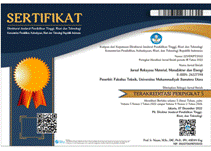Eksperimental Kekerasan Dan Struktur Mikro Pada Produk Foot Step Berbahan Limbah Alumunium Hasil Pengecoran Cetakan Pasir Silika Berpengikat Bentonit
Abstract
This study aims to determine the results of the hardness values of castings using silica sand molds on market products and the microstructure contained in the results of various mold castings. Aluminum is often used as a material for making automotive components, machinery, art objects, and household appliances. Aluminum is a lightweight metal that is corrosion resistant. The foundry industry has now developed a lot from metal casting to non-metal casting. One of the metal casting technologies known today is metal casting technology with sand casting, the casting carried out in this study uses sand molds. The materials used in this study include silica sand, bentonite, water, aluminum waste, and the tools used include patterns, melting furnaces, scales, sand paper. In this research, testing, hardness test and microstructure test were carried out. The results of the hardness test on the standard specimen have an average value of 76.33 BHN, the first mold variation specimen has an average value of 63.69 BHN, and the second mold variation specimen has an average value of 63.84 BHN. In the microstructure test, the first variation of the castings had good aluminum dispersion, a high level of porosity, and for the second variation specimen the castings had good aluminum dispersion and low porosity. After seeing the results of the hardness and microstructure tests, it can be explained that the market product has a better value for the test results, this is because the results of the castings use permanent molds, and it can also be seen that the results of the microstructure affect a hardness value of the two results of the bentonite-binding silica sand mold castings.
Keywords
Full Text:
PDFReferences
F. F. K. Palagan, Pengaruh Model Sistem Saluran Pada Proses Pengecoran Logam Al-Si Dengan Penggunaan 15% Lumpur Porong, Sidoarjo, Sebagai Pengikat Pasir Cetak Terhadap Cacat Cor Fluiditas Dan Kekerasan Cor, J. Tek. Mesin, no. 2, 2015.
A. M., Siregar, C. A., Siregar Pemanfaatan Logam Sisa Pemesinan Pada Kenalpot Guna Mengurangi Pencemaran Udara, 2021.
K. Roziqin, H. Purwanto, and I. at, Pengaruh Model Sistem Saluran Pada Proses Pengecoran Aluminium Daur Ulang Terhadap Struktur Mikro Dan Kekerasan Coran Pulli Diameter 76 Mm Dengan Cetakan Pasir, J. Momentum UNWAHAS, vol. 8, no. 1, p. 114152, 2012.
L. Bruno, Teknik Pengecoran Logam, J. Chem. Inf. Model., vol. 53, no. 9, pp. 307320, 2019.
D. Andrijono and , S., Bimtek Mutu Produk Cor Baling-Baling Kapal Nelayan Hasil Cetakan Pasir Dengan Bahan Dasar Skrap Aluminium Bagi Ikm Disperindag Kota Pasuruan, J. Pengabdi. Masy. Univ. Merdeka Malang, vol. 3, no. 2, 2018, doi: 10.26905/abdimas.v3i2.2589.
I. Astika, D. Putra Negara, and M. Agus Susantika, Pengaruh Jenis Pasir Cetak dengan Zat Pengikat Bentonit Terhadap Sifat Permeabilitas dan Kekuatan Tekan Basah Cetakan Pasir (Sand Casting), J. Energi Dan Manufaktur, vol. 4, no. 2, pp. 132138, 2010.
I. Irwana, Pembuatan Dan Analisa Kekerasan Dan Struktur Mikro Logam Paduan Aluminium Dengan Aditif 6 Fe 1 Ni (% Berat), p. 167, 2018.
R. Majanasastra, Analisis Sifat Mekanik Dan Struktur Mikro Hasil Proses Hydroforming Pada Material Tembaga (Cu) C84800 Dan Aluminium Al 6063, J. Ilm. Tek. Mesin Unisma 45 Bekasi, vol. 4, no. 2, pp. 116, 2016.
M. Suyitno, Salim, U. A., & Mahardika, Aplikasi Cetakan Permanen untuk Menigkatkan Produksi dan Kualitas Produk IKM Pengecoran Logam Kuningan, 2016.
Toni prasetyo Widodo, Pengaruh Kadar Semen Portland Dalam Pasir Cetak Terhadap Kekuatan Cetakan Pasir, Permeabilitas, Fluiditas, Kekerasan Logam Dan Kualitas Coran Logam Al-Si Dengan Metode Gravitasi Casting, pp. 17, 2000.
A. R. Nasution, Z. Fuadi, I. Hasanuddin, and R. Kurniawan, Effect of vegetable oils as cutting fluid on wear of carbide cutting tool insert in a milling process, IOP Conf. Ser. Mater. Sci. Eng., vol. 796, no. 1, 2020, doi: 10.1088/1757-899X/796/1/012001.
A. Rudi, A. Affandi, and Z. Fuadi, Pengaruh Cairan Pendingin Terhadap Kekasaran Permukaan Benda Kerja Pada Proses Face Milling, J. Rekayasa Mater. Manufaktur dan Energi, vol. 3, no. 1, pp. 1622, 2020, doi: 10.30596/rmme.v3i1.4524.
Rahmatullah, K. Umurani, and M. A. Siregar, Pengembangan Lintasan Pahat Pada Pengefraisan Umsu Menggunakan CNC TU-3A, J. Rekayasa Mater. Manufaktur dan Energi, vol. 4, no. 1, pp. 0815, 2019.
T. Surdia and S. Saito, Pengetahuan Bahan Teknik, 1985.
Dassault Systmes launches new SOLIDWORKS app, Reinf. Plast., vol. 59, no. 3, p. 125, 2015, doi: 10.1016/j.repl.2015.02.041.
Yani, M., & Siregar, A. M. (2018). Kekuatan Komposit Polymeric Foam di Perkuat Serat Tandan Kosong Kelapa Sawit Beban Tarik. In Prosiding Seminar Nasional Inovasi Teknologi dan Ilmu Komputer. Jilid (Vol. 1, pp. 216-221).
DOI: https://doi.org/10.30596/rmme.v5i1.10266
Refbacks
- There are currently no refbacks.

This work is licensed under a Creative Commons Attribution 3.0 License
Jurnal Rekayasa Material, Manufaktur dan Energi is abstracting & indexing in the following databases:
This work is licensed under a Creative Commons Attribution-ShareAlike 4.0 International License.
Statcounter View My Stats RMME














